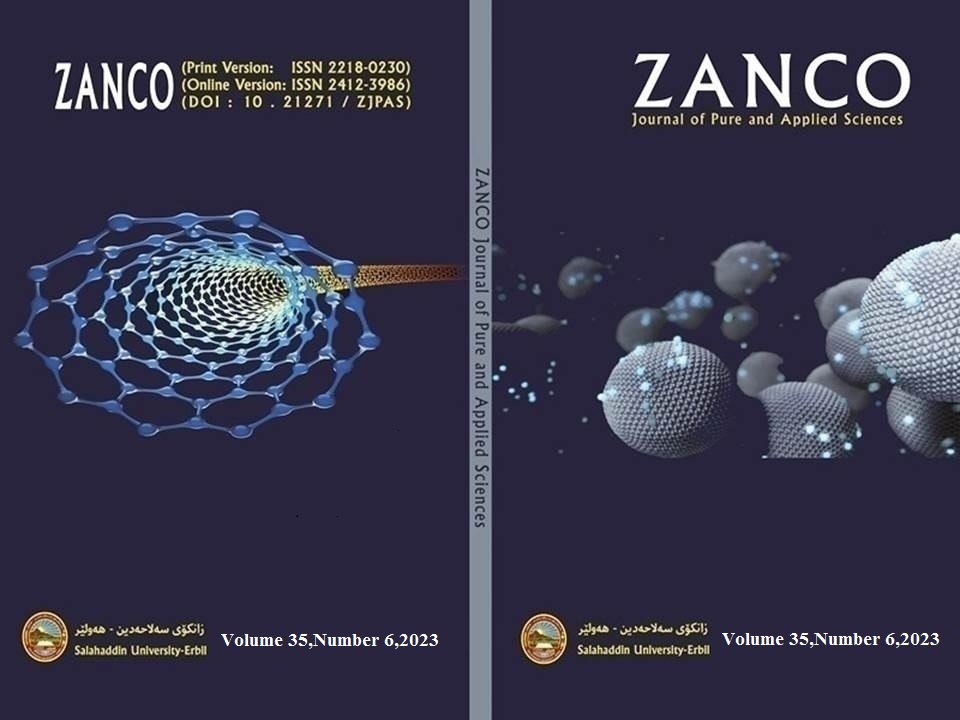Effect of forest exposure on growth and nutrient balance at Hijran forest.
DOI:
https://doi.org/10.21271/ZJPAS.35.6.16Keywords:
Growth characteristics, North east and south west exposures, nutrient balance, Oak trees.Abstract
The study was conducted during 2022 at Hijran forest at right side of the main road of Salahaddin - Shaqalawa in Erbil governorate Iraqi Kurdistan region with GPS reading (latitudes = 36°22' to 36º24' N; longitudes = 44°16' to 44°19' E.). This study was carried out to determine the effect of two forest exposures (north east and south west) using randomized block design using three replicates on growth and nutrient balance of oak trees (Quercus aegilops L.). Growth parameter including tree height (m), stem diameter (cm), and leaf area (cm2) as well as nutrient balance were measured according to the standard methods. The results indicated that the forest exposure affected significantly on the studied characters. The highest values of tree height, stem diameter at breast height level, and leaf area were (4.48 m, 11.03 cm, and 39.60 cm2) which were recorded from north east while their lowest values (3.22 m, 4.64 cm, and 25.78 cm2) were observed from south west.
On the other hand, the exposures also affected on nutrient balance, the nutrient balance at north east exposure was better than the south west. The difference between the ratios of the studied nutrients and their critical values were higher at north east exposure in comparing with south west.
The goals of this study is testing the influence Hijran forest exposure on nutrient balance and tree growth to notice some factors to be followed that affects widely on the reforestation program like site selection that must take into account elements including soil quality, topography, water availability, climate in addition to the selection of native tree species that can live in the degraded area and are well fit into the regional ecosystem; there is also to be the plantation of the variety of tree species to increase biodiversity
References
CHEN, L., HUANG, J. G., DAWSON, A., ZHAI, L., STADT, K. J., COMEAU, P. G. & WHITEHOUSE, C. 2018. Contributions of insects and droughts to growth decline of trembling aspen mixed boreal forest of western Canada. Global Change Biology, 24, 655-667.
DUTCĂ, I., CERNAT, A., STĂNCIOIU, P. T., IORAȘ, F. & NIȚĂ, M. D. 2022. Does Slope Aspect Affect the Aboveground Tree Shape and Volume Allometry of European Beech (Fagus sylvatica L.) Trees? Forests, 13, 1071.
EGLI, M., SARTORI, G., MIRABELLA, A., FAVILLI, F., GIACCAI, D. & DELBOS, E. 2009. Effect of north and south exposure on organic matter in high Alpine soils. Geoderma, 149, 124-136.
ESMAIL, A. O., ALI, O. O. & ABDULRAHMAN, N. M. 2011. Effect of forest exposure on nutrient balance in oak (Qurecus aegilops). Journal of Kirkuk University –Scientific Studies 6, 170-175.
GALALAEY, A. M., SHABAN, M. A., RASUL, K. M. A., DARWESH, D. T., UZUN, A., YOUSSEF, S. M. A. & ALMA, M. H. 2021. Ethnobotanical study of some wild edible plants in Hujran Basin, Kurdistan Region of Iraq. Zanco Journal of Pure and Applied Sciences, 33, 19-30.
GOOR, A. Y. & BARNEY, C. W. 1976. Forest tree planting in arid zones. Forest tree planting in arid zones.
HAGEN-THORN, A., ARMOLAITIS, K., CALLESEN, I. & STJERNQUIST, I. 2004. Macronutrients in tree stems and foliage: a comparative study of six temperate forest species planted at the same sites. Annals of Forest Science, 61, 489-498.
Downloads
Published
How to Cite
Issue
Section
License
Copyright (c) 2023 Narin S. Ali, Rushdy R. Aziz, Zhala B. Taha

This work is licensed under a Creative Commons Attribution 4.0 International License.














